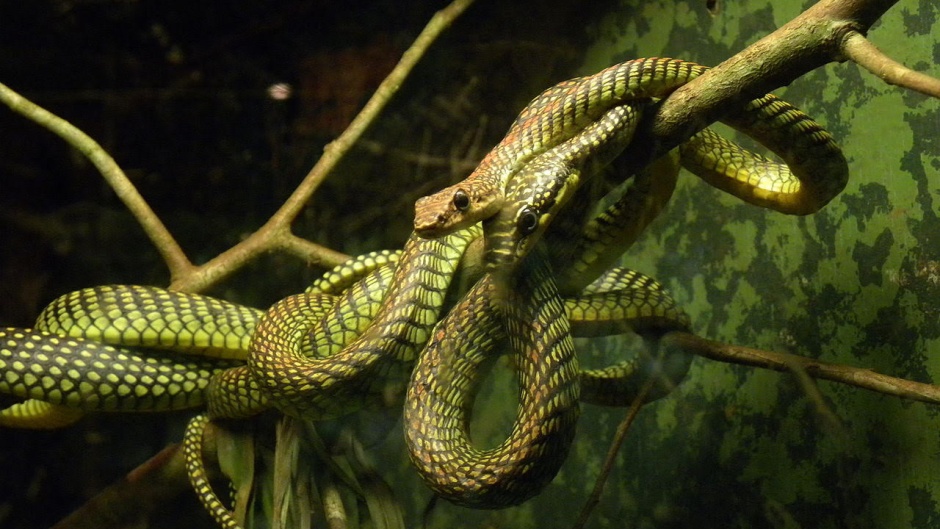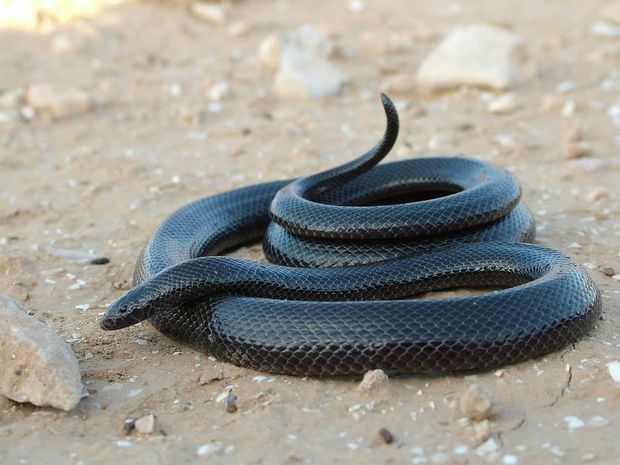Serpents in the Bible
Among the most dangerous snakes for human beings that can still be found in Israel are the following: the black desert cobra, the Palestine viper, the Palestine ladder snake, the horned desert viper.
13 FEBRUARY 2022 · 11:00 CET

And God said, “Let the land produce living creatures according to their kinds: the livestock, the creatures that move along the ground, and the wild animals, each according to its kind.” And it was so. (Gn. 1:24)
“Serpent” is the generic term that is most frequently used in the Bible for ophidian reptiles. However, many different terms occur in the Scriptures to refer to different subspecies. The term “serpent” appears almost 50 times, while other terms such as “asp”, “viper” and “snake” are also used. In Hebrew there are eight terms for ophidians, and it is not always possible to identify the specific species in each case. The most common term in the Old Testament for serpent or snake is najash and in the New Testament it is ophis, a Greek word.
The Pentateuch describes the serpent in the garden of Eden as an astute animal, with a head, a chest, with which it pulled itself along the ground, and a tail (Gn. 3v1, 14.15; Exodus 4 v 4). In other instances it is closely associated with the dust of the earth, as its tongue touches the ground continually to pick up the scent of the trail left my its prey (Micah 7v17; Isaiah 65v25). God formed man from the dust of the earth (Gn. 2v7), and it would seem that the serpent – identified with the father of lies – wished to “eat” this same dust in order to continue tempting human beings.
The original snake bite delivers the lethal poison of scepticism with regard to the identity of God, just as their descendants in the desert, the fiery serpents, would later kill many Israelites (Gn 3v1-5; Num. 21v6; Psalm 58v3-5; Prov. 23:32). They are animals that can live in any habitat: along roadsides, among rocks, in walls and even inside human dwellings (Gn. 49v17; Num. 21v6; Prov. 30v19; Ecc. 10v8; Am. 5v19).
The concept of the fiery serpent, mentioned in Hebrew as hannejashim hasseraphim (Num. 21v6), could refer to any of a whole range of poisonous ophidians, whose bite is lethal for human beings, that still exist in Israel, the Sinai and Arabian Peninsulas.
Herpetologists have counted 42 different species in Israel, belonging to 7 different families and 27 genera. [1] Of these 42 species, almost half have a poison capable of killing a human being. Fortunately, most of them live in the desert and have nocturnal habits, so they seldom come into contact with people.

Photo: Laxotam On the other hand, the Biblical references to “flying serpents” (Is. 14v29; 30v6), which are common in modern Arabia, probably refers to a species which leaps from branch to branch, and can even jump from treetops onto their victims as they pass nearby. There are tree-dwelling ophidians which can leap, glide and even twist and turn in the air to gain momentum as they move through the treetops, or to reach the ground more quickly, across distances of up to 100 metres. They can spread their ribs and flatten their bodies and thus double their body-width, which enhances their gliding capacity. One such serpent is the Chrysopelea paradisi, of the Colubridae family, which lives in southeast Asia.
Likewise, the adjective “fiery” could refer to the intense burning sensation caused by the poison delivered by the bite, although some scholars think that it has more to do with the colour of the skin of some specimens. Among the numerous poisonous species of herpetofauna in Israel there are some, including the Montpellier snake (Malpolon monspessulanus insignitus), which are capable of climbing bushes and trees to hunt down birds or lizards, and then leap down to the ground to catch rodents as well.
Another species, which has very different habits, but which has one of the most powerful poisons known to exist, is the Israeli mole viper (Atractaspis engaddensis) is a black snake measuring about a metre long, and lives in underground cavities in the Negev desert, around the Dead Sea, but has also been seen in Jordan and Arabia. It only comes out at night to catch small prey.
Among the most dangerous snakes for human beings that can still be found in Israel are the following: the black desert cobra (Walterinnesia aegyptia), the Palestine viper (Daboia palaestinae); the Palestine ladder snake (Echis coloratus terraesanctae); the horned desert viper (Cerastes cerastes); the Arabian horned viper.

The one which bit the apostle Paul on Cyprus (Acts 28:3-5) bust have been a European species, such as the asp (Vipera aspis), as there were still venomous species on the island at that time. It appears that Helen, Constantine’s mother, later in the 4th century AD) brought cats to Cyprus to put an end to the venomous species of snake that Cyprus was infested with.
The book of Genesis represents the serpent as the animal intermediary in the temptation of Eve (Gn 3:1-14). The editor of the text was aware that snakes neither reason nor talk, and that this primeval ophidian symbolically embodied the power of evil in opposition to the Creator. In fact, in the mind of ancient Orientals serpents were considered malignant and demonic as the poison they possessed could kill. However, the author of the Genesis narrative also refers to “the great dragon, the ancient serpent called the devil and Satan, who deceives the whole world”, according to the apostle John (Rev. 12:9) as a simple ophidian, a creature lacking limbs. It is not represented as a divine being belonging to another world. It is not a god rivalling Yahweh, also worthy of being worshipped. It is simply a created being, dragging itself along the ground.
The New Testament frequently refers to the idea that the serpent in Eden was an instrument of the devil, homicidal and the father of all lies (John 8:44); who will be crushed by the God of peace, under the feet of those who announce his truth (Romans 16:20); but from whom we must distance ourselves because, just as he used shrewdness to deceive Eve, so he continues tempting every believer (2 Cor. 11;13). Thus the original curse fell first on the serpent, henceforth cursed among all the animals and seen as an object of horror by human beings, but it also fell on the devil himself, whose head would be crushed by Jesus Christ, the seed of the woman (Gn. 3:14-15; Col. 2:15; He. 2:14). One of the manifestations of the sincere faith of the first Christians would be precisely that they would be immune to the poison of serpents, as evidence of the power of Jesus Christ living in them and capable of overcoming the power of the evil one (Mk. 16:18). That said, the Master himself highlighted a positive feature of these animals when he instructed his disciples to be “as astute as serpents” (Mt. 10:16). That is to say, shrewd, judicious and wise.
In some cultures snakes did not have the negative connotations that they had in biblical times. In some ancient myths, such as the Akkadian Gilgamesh epic, the fact that ophidians periodically changed their skin was seen as a symbol of rejuvenation and immortality. That is why some people groups began to worship serpents, not only because they changed their skin, but also because they disappeared in winter and hid in underground cavities, before being reborn in Spring, when the temperatures rose. This phenomenon associated them with the fertility of nature. The worship of the serpent is a constant which appears in many of the world’s religions and in regions as far apart as India, China, Chaldea, Babylon, Greece, Rome, Egypt, Japan, Africa, America and Oceania. Gods in ophidian forms are worshipped almost throughout the globe. The Romans were so fond of snakes that they kept them as pets in their homes and thermal baths. Needless to say, these were non-venomous snakes, which represented the gods of the underworld, associated with agrarian cycles.
In a commentary on the words “The wicked plot against the righteous and gnash their teeth at them” (Psalm 37:12) Charles Spurgeon wrote the following:
“Why can he not let the good man alone? Because there is enmity between the serpent's seed and the seed of the woman. Why not attack him fairly? Why plot and scheme? Because it is according to the serpent's nature to be very subtle. Plain sailing does not suit those who are on board of "The Apollyon." [2]
This name, Apollyon, appears in the book of Revelation: “And they had a king over them, which is the angel of the bottomless pit, whose name in the Hebrew tongue is Abaddon, but in the Greek tongue hath his name Apollyon.” (Rev. 9:11). This was, symbolically, the boat that carried the damned to Hell, and the name of the captain was Apollyon, which literally meant “the destroyer”.
Notes
[1] Bar, A. & Haimovitch, G. 2011, A Field Guide to Reptiles and Amphibians of Israel, Herzliya, Israel, pp. 117-201.
[2] Spurgeon, C. H. The Treasury of David
Published in: Evangelical Focus - Zoe - Serpents in the Bible
